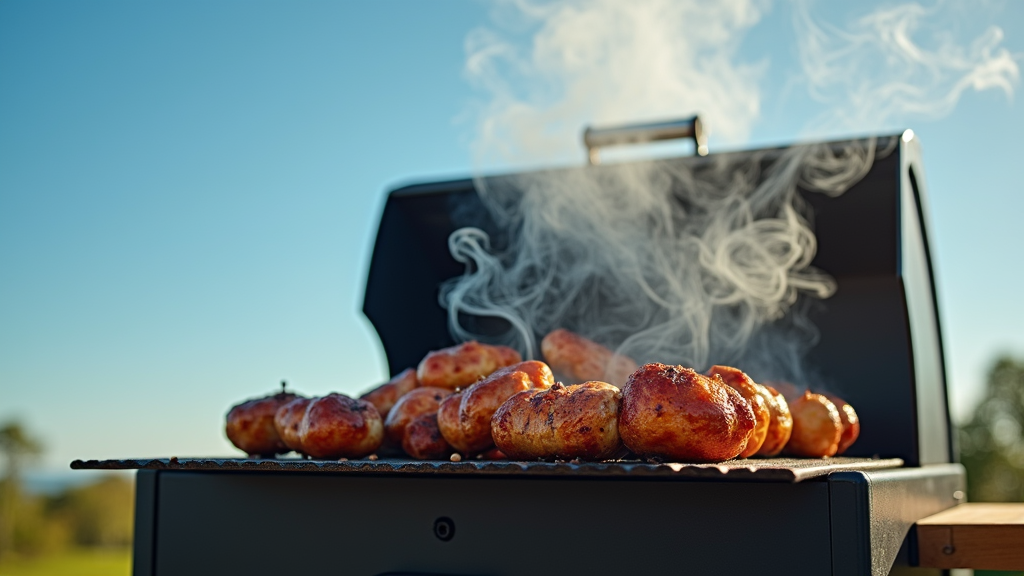Smoke rings are a true art in the world of barbecue. If you’ve spent time with a pellet grill, you may have admired those delicate pink bands on your meat. It might seem almost magical. I discovered that achieving smoke ring perfection isn’t just about the grill. It is a harmonious blend of the right equipment, proper technique, and a bit of science. Every element plays a part in producing that appealing visual treat that many grill enthusiasts treasure.

Essential Equipment for Perfect Smoke Rings
Using a pellet grill demands the right equipment. A well-built pellet grill keeps the temperature steady and guarantees a consistent smoke flow. Dedicated tools – such as a reliable pellet grill, premium wood pellets, digital thermometers, and quality meat – all work together to help you capture that sought-after smoke ring with every cook. Modern pellet grills even come with technology that monitors the temperature inside and automatically adjusts the pellet feed. This means you can experiment with different types of wood pellets and techniques without having to constantly check on the grill. Having the proper tools makes the whole process smoother and allows you to focus on your cooking.
Understanding the Science Behind Smoke Rings
Smoke rings form when nitrogen dioxide interacts with the meat’s myoglobin, turning it pink. Although the science behind it sounds complicated, knowing these basics gives you a head start in perfecting your technique. There are a few key factors to keep in mind:
- Temperature: Low heat allows the smoke more time to interact with the meat, resulting in a thicker, more defined ring.
- Wood Pellet Quality: High-quality pellets burn cleanly, generating a purer smoke that contributes to a better ring.
- Moisture: A slightly damp meat surface attracts smoke particles. A light spritz of water or a quick brine before cooking can step up the smoke ring formation.
Even a basic understanding of these elements gives you the freedom to experiment and refine your methods, ensuring that each cooking session has the potential to produce an impressive, eye-catching finish.
Quick Guide to Smoke Ring Perfection
If you’re just getting started, here is a straightforward set of steps to help you achieve that perfect smoke ring:
- Preheat the Grill: Allow your pellet grill to reach a steady, low temperature. Patience here is very important. Give the grill enough time to stabilize before adding your meat.
- Select Quality Pellets: Choose hardwood pellets like hickory or applewood. These provide a steady, clean smoke that is essential for a defined ring.
- Prepare the Meat: Ensure the surface of your meat is slightly moist. You don’t need to soak it; simply a light spray or quick brine will do the trick.
- Maintain a Consistent Temperature: Keep the temperature low and stable throughout the cooking process. A reliable digital thermometer can help you keep track so that the meat cooks slowly and evenly.
- Keep the Grill Clean: Old residue may affect the smoke quality. Regular cleaning of your grill ensures that previous flavors do not interfere with your current cook.
Following these steps gives you a reliable framework for achieving both an enticing smoke ring and a delicious flavor profile with every meal.
Challenges to Consider Before You Begin
No culinary art is without its challenges, and smoke ring formation is no different. Being aware of potential hurdles can help you plan better and avoid common pitfalls. Some issues to watch out for include:
- Pellet Quality: Not all wood pellets are created equal. Cheaper pellets might burn too fast or produce off-flavors that mask the desired pink smoke ring.
- Temperature Consistency: Your grill must hold a steady, low temperature for a long period. Any fluctuation in heat can lead to uneven smoke rings or less pronounced flavor.
- Moisture Levels: Too much moisture may cause steaming, while too little will not capture enough smoke. Finding the right balance is almost an art in itself.
- Weather Conditions: Even the best pellet grills can be affected by the weather. Strong winds, cold days, or high humidity may throw off your temperature control and smoke flow.
Pellet Quality
After some trial and error, I learned that only high-quality, well-seasoned pellets can consistently produce that deep smokiness. Cheaper options often fall short because they burn inconsistently and can introduce unwanted flavors to your meat.
Temperature Consistency
Maintaining a constant temperature is a significant challenge. Using an accurate digital thermometer and knowing the hot spots on your grill makes a big difference. Some advanced pellet grills even have a system to automatically adjust the pellet feed. This feature helps ease up issues with overheating, but a bit of manual checking is always a good idea.
Moisture Balancing
Getting the moisture level just right is essential. A light mist on your meat can be the deciding factor between a bland outcome and that signature pink band that signals a well-executed cook. I recommend experimenting with a gentle spray during longer cooking sessions.
Weather Conditions
The outdoor environment plays a very important role in your grilling results. Cold or rainy weather may disrupt temperature stability, while high humidity can alter how smoke interacts with the meat. Planning your grilling sessions around favorable weather conditions can help ensure better outcomes.
Advanced Smoke Ring Techniques
Once you feel comfortable with the basic methods, you can try a few advanced techniques to further boost your results. These techniques are not only about improving the visual appeal but also about locking in flavor:
Reverse Sear Technique: Start by cooking your meat slowly at a low temperature to develop the smoke ring. Later, increase the heat for a quick sear. This final step helps lock in juices and produces an appealing contrast in texture.
Pellet Blending: Experiment with different types of wood pellets. By mixing milder pellets with those that have a stronger profile, you can create a unique balance of flavors and smoke intensity.
Extended Low Temperature Cooking: Increasing the cooking time at lower temperatures may result in a thicker smoke ring. This method allows the smoke to penetrate deeper into the meat and is all about balancing cooking time with quality.
These advanced techniques can take your skills to the next stage. While they might seem challenging at first, a solid grasp of the basics will help you experiment and find what works best for you.
The Basics: Creating Delicious Flavors
The pellet grill is not simply a tool for achieving smoke rings. It is a generator of deep, complex flavors. When combined with the right herbs, spices, and marinades, the smokiness from the pellets can transform an ordinary cut of meat into a layered, aromatic feast.
- Flavor Infusion: As the smoke mingles with the meat’s natural juices, it adds a distinctive taste that is both subtle and evolving with every bite.
- Seasoning and Marinades: A good rub or marinade should step up the natural smokiness without overwhelming it. Experiment with a few spice blends to see which one best complements your meat and smoke.
- Complementary Sides: Don’t forget to consider the sides. Choosing the right accompaniments can bring together the flavors and create a complete meal experience.
Getting the basics right not only helps you achieve an eye-catching smoke ring but also ensures that every bite bursts with flavor.
Frequently Asked Questions
I often get questions about smoke ring formation and pellet grilling techniques. Here are some common queries along with straightforward answers:
Question: What is the most important factor in creating a distinct smoke ring?
Answer: The combination of steady low temperature, high-quality wood pellets, and a properly moistened meat surface is very important in developing a robust smoke ring.
Question: How do weather conditions affect smoke ring formation?
Answer: Weather plays a key role. Calm and predictable conditions allow for smooth temperature control, while windy or humid days may require you to make small adjustments during cooking.
Question: Is it necessary to use new pellets every time?
Answer: Not always. However, using fresh, high-quality pellets whenever possible helps maintain a consistent smoke output, which is very important for that perfect ring.
Question: Can techniques like the reverse sear affect the smoke ring?
Answer: Yes. When done correctly, starting with low heat builds the smoke ring, and the final sear locks in moisture and flavor without completely destroying the ring’s appearance.
Conclusion
Achieving the perfect smoke ring on a pellet grill is an art that blends science, technique, and passion for quality barbecue. Every step – from the initial preheat to the final sear – contributes to the signature pink band that many pitmasters admire. The adventure toward smoke ring perfection is filled with experiments, adjustments, and learning opportunities.
With the proper equipment, an understanding of the science behind smoke, and a willingness to try advanced techniques, you can consistently produce both an attractive smoke ring and an amazing flavor profile. Every cook teaches you something new, and even small tweaks can lead to delicious results.
Remember that barbecue is not just about following a recipe; it is about enjoying the process and making each session your own. So fire up your grill, trust your instincts, and most of all, have fun as you explore the many dimensions of pellet grilling. Bottom line: a little practice and attention to detail will reward you with truly unforgettable meals.
